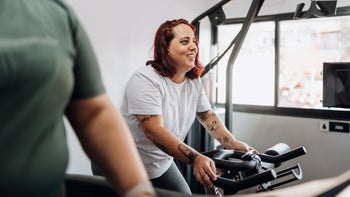
7 Bunion Exercises for Pain Relief and Prevention
Key takeaways:
Bunions result when the big toe moves inward, forming a bony bump at the base of the toe. Bunions restrict movement and can be painful.
Poorly fitting shoes often cause bunions, but genetics also play a role.
Bunion exercises can align, strengthen, and increase the range of motion in your big toes. They may also reduce pain and prevent bunions from getting worse.

Generally, your toes point straight. But if you notice your big toe shifting inward, it could be a sign that a bunion is forming. Not only do bunions cause a large bump at the base of the big toe, but they can be painful, too.
Wearing tight, ill-fitting shoes may cause bunions to form slowly over time. Compression from tight shoes can change the normal alignment of the big toe. Bunions can make standing and walking uncomfortable, so catching the problem early can prevent bunions from getting worse.
Bunion exercises to strengthen your toes can help keep you on your feet.
Search and compare options
What are the best exercises and stretches for bunions?
Certain footwear can increase the risk of developing a bunion. Tight, narrow shoes or high heels, especially those with a pointed toe, squeeze the toes together. Over time, the big toe may move inward toward the other toes on the same foot. Frequent pressure pushing the big toe inward places stress at the base of the big toe, causing a bump to form on the outside.
Genetics may make bunions more likely to form, even if you wear supportive shoes. Bunions change the normal alignment of the big toe joint, which can result in pain over time.
Targeted bunion exercises –– including strengthening and stretching –– may realign the big toe, restore movement, and decrease pain.
Practice bunion exercises while barefoot. Begin the following exercises and stretches by sitting in a comfortable chair with your feet flat on the floor, unless stated otherwise.
1. Big toe circles
Toe circles work the joint in your big toe. They're designed to improve joint mobility and reduce pain and pressure.
Step 1: Cross one leg over the other and grab your big toe.
Step 2: Use your hands to gently rotate your big toe in small circles.
Step 3: Perform 20 times in one direction, then switch and perform 20 times in the opposite direction.
Step 4: Repeat on the other foot.
Read more like this
Explore these related articles, suggested for readers like you.
2. Toe spread-outs
Toe spread-outs can strengthen the small muscles that allow you to spread your toes, and they can help prevent a bunion from forming. Keeping your toes moving can also prevent stiffness, which may lessen the likelihood of arthritis.
Step 1: Extend one leg straight in front of you.
Step 2: Keep the ball of your foot on the floor as you lift your toes up and spread them apart.
Step 3: Hold for 5 seconds, then relax.
Step 4: Repeat 20-30 times on each foot.
3. Toe curl and point
The toe curl and point exercise works muscles in your feet and toes simultaneously. The targeted muscles help support your foot arch and toe mobility with walking, which can be limited by bunions.
Step 1: Extend one leg straight and lift your foot from the floor.
Step 2: Squeeze the foot muscles in your extended leg to tighten your arch, and point your toes down.
Step 3: Hold for 5 seconds, then relax.
Step 4: Repeat 20-30 times on each foot.
4. Big toe extension
This stretch isolates and extends muscles in the big toe to restore movement. Extending your big toe helps you walk and maintain your balance.
Step 1: Lift your big toe while keeping your other four toes on the floor. Try to keep your heel and the ball of your foot on the floor, too.
Step 2: Hold for 5 seconds, then relax.
Step 3: Repeat 20-30 times on each foot.
5. Heel raises
Heel raises are a great way to strengthen calf, ankle, and foot muscles. They can make it easier to extend your toe while in weight-bearing positions. This motion allows your foot to push off when transferring your weight from one foot to the other while walking.
Step 1: Stand behind a sturdy chair with your knees slightly bent. You can hold the back of the chair for extra support.
Step 2: Keep your toes and the ball of your foot on the floor. Lift your heel as high as you can while pressing your toes into the floor. You should feel movement through your ankles and toes.
Step 3: Hold for 5 seconds, then relax.
Step 4: Repeat 20-30 times on each foot.
6. Towel scrunches
Practicing towel scrunches can strengthen muscles in your toes and the arch of your foot for better movement.
Step 1: Sit in a chair with your feet flat on top of a towel.
Step 2: Curl the toes on one foot to grasp and scrunch the towel between your toes.
Step 3: Hold for 5 seconds, then relax.
Step 4: Repeat 20-30 times on each foot.
7. Toe abduction
Abduction refers to movement away from the body. Raising your arms out to the side is an example of abduction.
Working on toe abduction, or moving the big toes away from the other toes, can help improve alignment and mobility.
Step 1: Keep your feet flat on the floor as you spread your toes outward. Your big toe may move outward, but your other toes might not move as much.
Step 2: Hold for 5 seconds, then relax.
Step 3: Repeat 15-20 times on each foot.
Are there other remedies for bunions?
Proper footwear is essential for treating bunions and preventing them from getting worse. It is important to wear supportive shoes with a wide toe box that does not squeeze the toes.
Dress shoes, flats, and high heels often have narrow toe boxes. Limit wearing these types of shoes as much as possible, or switch to other options that are wider or have an open-toe design.
Orthotics may also help. These shoe inserts provide added support that may ease pain or help with proper alignment. Toe spreaders can help keep your toes separated. And toe splints or bunion shields can stabilize the big toe and reduce irritation at the bunion.
Taking a short course of over-the-counter pain medication and applying ice to your bunions may also help relieve pain.
When should you see a doctor about bunions?
If you have significant pain that limits your ability to stand or walk, talk to a healthcare provider. Bunions can lead to other foot problems, such as bursitis, arthritis, or chronic pain.
The big toe also plays an important role in the heel-toe walking pattern. If bunions change the alignment and movement of your big toe, they can lead to mobility problems. Your provider might recommend working with a physical therapist to strengthen your foot muscles and improve mobility.
Severe cases may require bunion surgery. Surgery helps realign the big toe, allowing your toes and feet to move freely with less pain.
The bottom line
A bunion is a bony bump at the base of the big toe. Usually, tight shoes are to blame, but genetics also play a role in developing a bunion. Exercises that improve the movement and strength of your big toe and foot arch can help reduce bunion pain. Shoes with wide toe boxes, toe orthotics, pain medication, and ice can also help reduce your symptoms.
If severe pain limits your ability to stand or walk, talk with a healthcare provider. Pain management or surgical options may be needed for ongoing problems.
Why trust our experts?



References
Alkhalifah, K.M., et al. (2023). A systematic review and meta-analysis of the prevalence of hallux valgus in the general population. Cureus.
Foot Health Facts. (n.d.). Bunions. American College of Foot and Ankle Surgeons.
Institute for Quality and Efficiency in Health Care. (2018). Bunions: Overview.
Ji, L., et al. (2022). Minimally invasive vs. open surgery for hallux valgus: A meta-analysis. Frontiers in Surgery.
Journal of Orthopaedic & Sports Physical Therapy. (2016). Bunion: Strengthening foot muscles to reduce pain and improve mobility.
NHS Inform. (2023). Toe curl [video]. YouTube.
Nix, S.E., et al. (2013). Gait parameters associated with hallux valgus: A systematic review. Journal of Foot and Ankle Surgery.
OrthoInfo. Bunion surgery. American Academy of Orthopaedic Surgeons.
OrthoInfo. Bunions. American Academy of Orthopaedic Surgeons.
Park, C.H., et al. (2019). Forefoot disorders and conservative treatment. Yeungnam University Journal of Medicine.
Rehab My Patient. (2014). Toe abduction exercise [video]. YouTube.
Southwest Foot and Ankle Centre. (2021). Towel scrunch exercise to strengthen your feet [video]. YouTube.
Ying, J., et al. (2021). Adjusted indirect and mixed comparisons of conservative treatments for hallux valgus: A systematic review and network meta-analysis. International Journal of Environmental Research and Public Health.





























